Heads up – Massive Sports Tech Holiday Deals List is Live!!! The Garmin Fenix 8 is $250 off (even the Fenix 8 Pro is $100 off!), the Apple Watch Ultra 3 is on sale, the Garmin inReach Mini 2 is $249, the GoPro Hero 13 Black, DJI NEO, and a ton of other brands/deals, including Wahoo, Oura, Whoop, Polar, Samsung, Google, and more than 100 sports tech deals here!
I’m DC RAINMAKER…

I swim, bike and run. Then, I come here and write about my adventures. It’s as simple as that. Most of the time. If you’re new around these parts, here’s the long version of my story.

You'll support the site, and get ad-free DCR! Plus, you'll be more awesome. Click above for all the details. Oh, and you can sign-up for the newsletter here!
Here’s how to save!
Wanna save some cash and support the site? These companies help support the site! With Backcountry.com or Competitive Cyclist with either the coupon code DCRAINMAKER for first time users saving 15% on applicable products.
You can also pick-up tons of gear at REI via these links, which is a long-time supporter as well:Alternatively, for everything else on the planet, simply buy your goods from Amazon via the link below and I get a tiny bit back as an Amazon Associate. No cost to you, easy as pie!
You can use the above link for any Amazon country and it (should) automatically redirect to your local Amazon site.
While I don't partner with many companies, there's a few that I love, and support the site. Full details!

Want to compare the features of each product, down to the nitty-gritty? No problem, the product comparison data is constantly updated with new products and new features added to old products!

Wanna create comparison chart graphs just like I do for GPS, heart rate, power meters and more? No problem, here's the platform I use - you can too!

Think my written reviews are deep? You should check out my videos. I take things to a whole new level of interactive depth!

Smart Trainers Buyers Guide: Looking at a smart trainer this winter? I cover all the units to buy (and avoid) for indoor training. The good, the bad, and the ugly.
-
Check out my weekly podcast - with DesFit, which is packed with both gadget and non-gadget goodness!

Get all your awesome DC Rainmaker gear here!
FAQ’s
I have built an extensive list of my most frequently asked questions. Below are the most popular.
- Do you have a privacy policy posted?
- Why haven’t you yet released a review for XYZ product you mentioned months ago?
- Will you test our product before release?
- Are you willing to review or test beta products?
- Which trainer should I buy?
- Which GPS watch should I buy?
- I’m headed to Paris – what do you recommend for training or sightseeing?
- I’m headed to Washington DC – what do you recommend for training?
- I’m from out of the country and will be visiting the US, what’s the best triathlon shop in city XYZ?
- What kind of camera do you use?
-
5 Easy Steps To The Site
In Depth Product Reviews
You probably stumbled upon here looking for a review of a sports gadget. If you’re trying to decide which unit to buy – check out my in-depth reviews section. Some reviews are over 60 pages long when printed out, with hundreds of photos! I aim to leave no stone unturned.
Read My Sports Gadget Recommendations.
Here’s my most recent GPS watch guide here, and cycling GPS computers here. Plus there are smart trainers here, all in these guides cover almost every category of sports gadgets out there. Looking for the equipment I use day-to-day? I also just put together my complete ‘Gear I Use’ equipment list, from swim to bike to run and everything in between (plus a few extra things). And to compliment that, here’s The Girl’s (my wife’s) list. Enjoy, and thanks for stopping by!
Have some fun in the travel section.
I travel a fair bit, both for work and for fun. Here’s a bunch of random trip reports and daily trip-logs that I’ve put together and posted. I’ve sorted it all by world geography, in an attempt to make it easy to figure out where I’ve been.
My Photography Gear: The Cameras/Drones/Action Cams I Use Daily
The most common question I receive outside of the “what’s the best GPS watch for me” variant, are photography-esq based. So in efforts to combat the amount of emails I need to sort through on a daily basis, I’ve complied this “My Photography Gear” post for your curious minds (including drones & action cams!)! It’s a nice break from the day-to-day sports-tech talk, and I hope you get something out of it!
The Swim/Bike/Run Gear I Use List
Many readers stumble into my website in search of information on the latest and greatest sports tech products. But at the end of the day, you might just be wondering “What does Ray use when not testing new products?”. So here is the most up to date list of products I like and fit the bill for me and my training needs best! DC Rainmaker 2024 swim, bike, run, and general gear list. But wait, are you a female and feel like these things might not apply to you? If that’s the case (but certainly not saying my choices aren’t good for women), and you just want to see a different gear junkies “picks”, check out The Girl’s Gear Guide too.


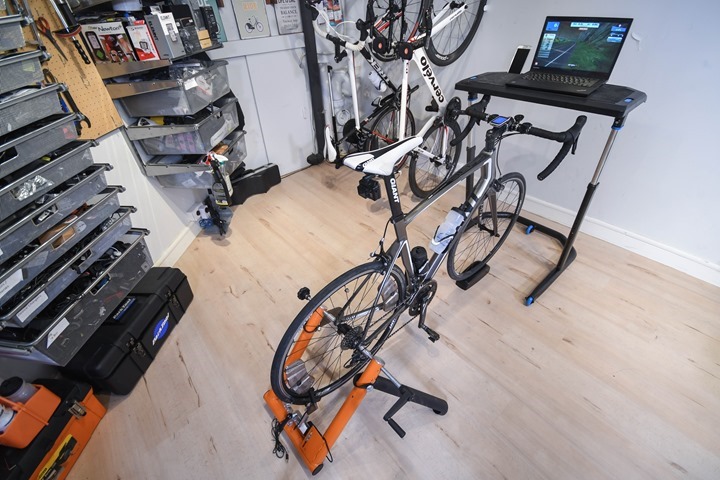
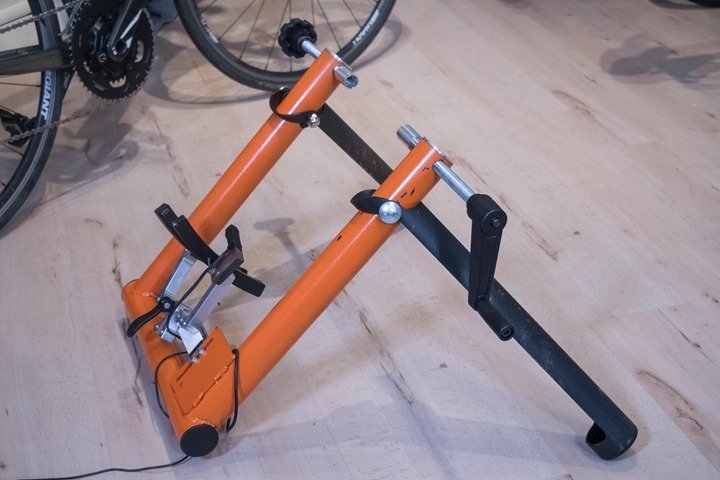
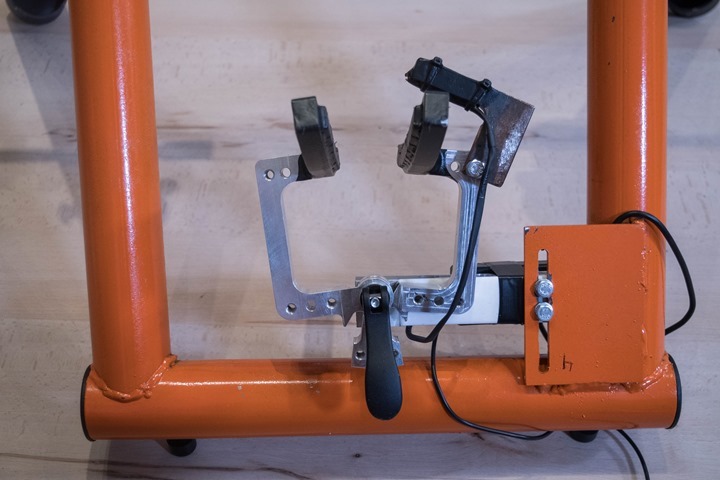
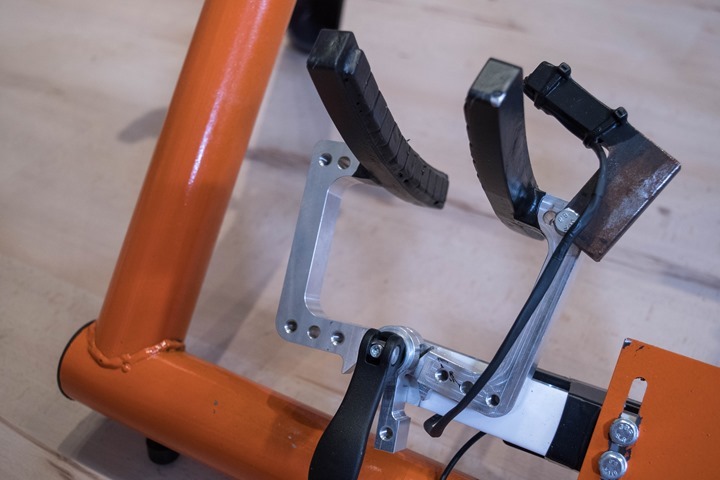
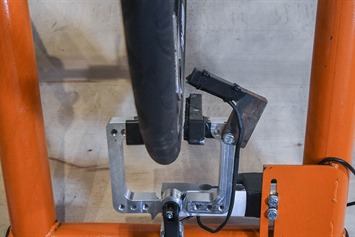
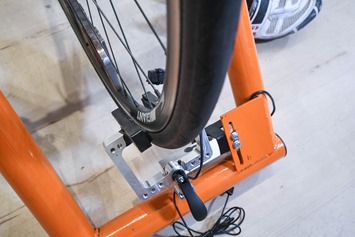
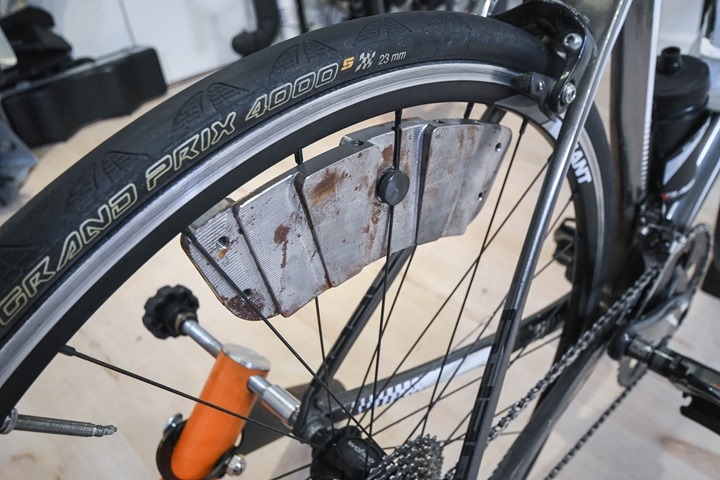
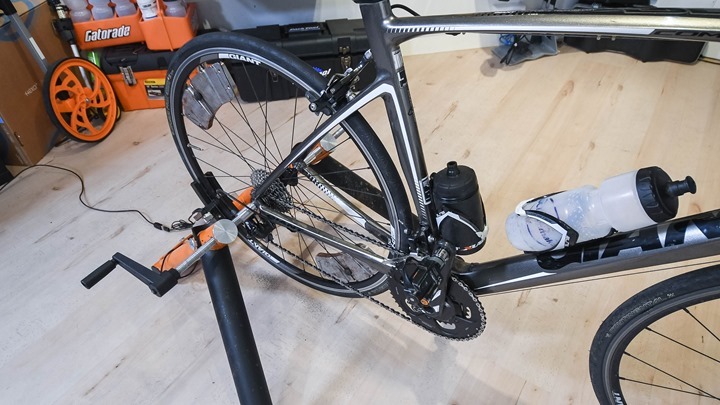
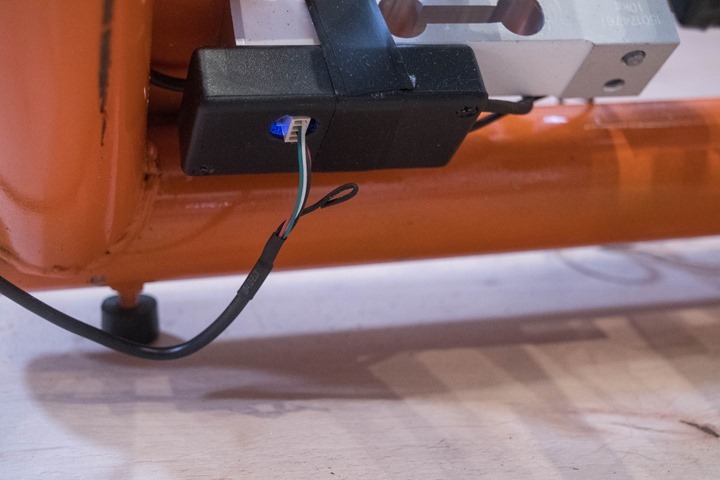
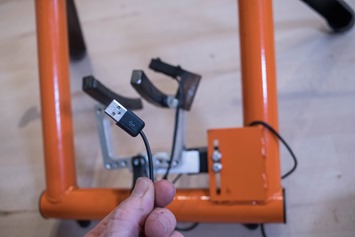
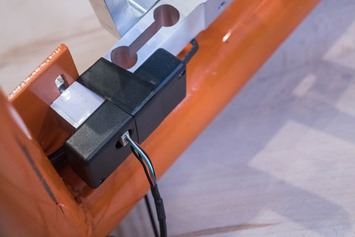
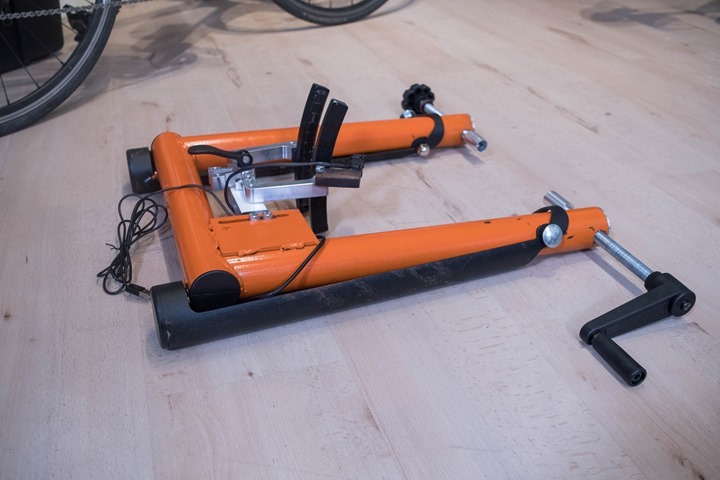
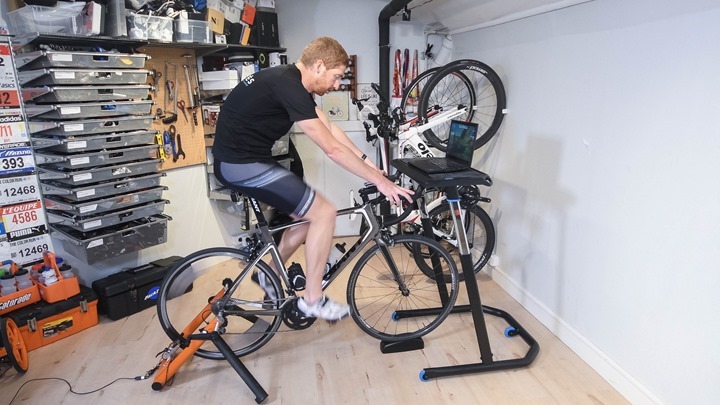

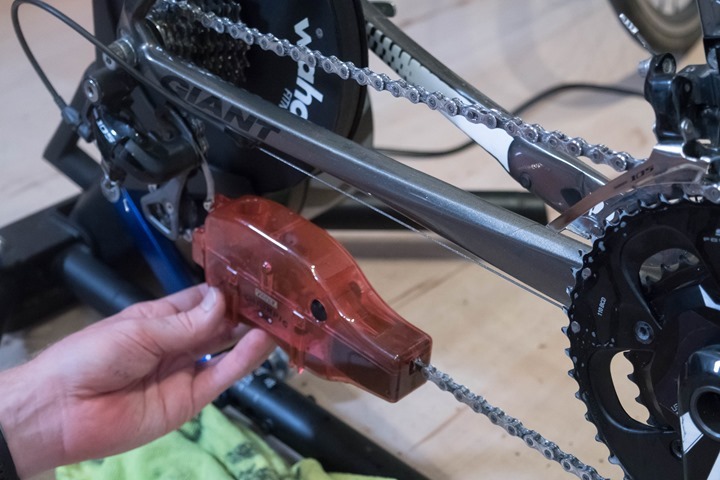
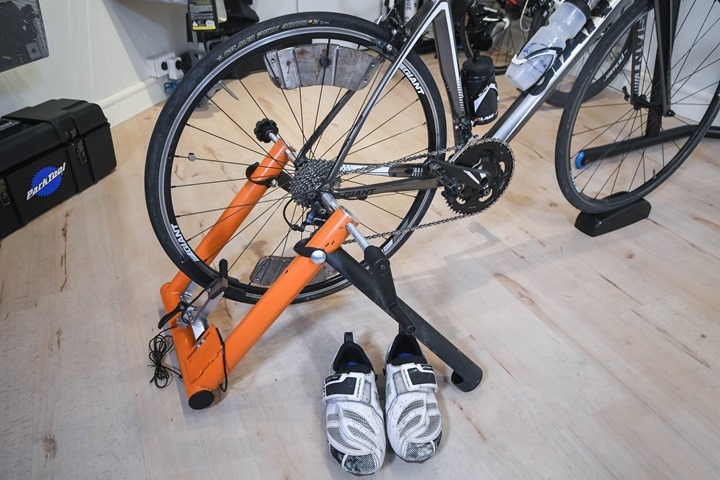




















Hi Ray, This looks really interesting.
A quick note about the new intro to your videos. The volume level at the start is really high, so I have to lunge for the volume controls to pot down the music. Then I need to increase levels again, once your review starts. Noticed this on multiple videos including the one above. Please reduce the level on the intro music.
That said. Great video, as always.
Thanks. I’ll lower it more. I had normalized it to the same level as the rest of the video, but perhaps I can pull it down more.
I wonder if those weights on the spokes won’t damage your spokes in the long run, like bending them. Must be a lot of force they endure during acceleration and deacceleration.
I had wondered the same thing, but the way it sits, it’s basically force against the wheel rim/frame. Versus something pushing sideways on the spokes that would be more unnatural.
Would it not also be possible to use the trainer without the weights?
(just like using a trainer without a flywheel – not the greatest feeling, but if you don’t want to take any chances with your nice wheels it might be an option when pressed for time (I would propably opt for a separate wheel to use with this when it arrives – first kickstarter for me (non-power version))
Its funny – I have allways wanted a 10kg rear wheel for my rollertrainer to act as a flywheel – while these weights might work, I gather they might not be all that safe for other applications.
Ibeti – It is completely possible to use the trainer without weights; on a light wheel, it forces you to pedal in circles. MTB wheels (or heavier road wheels) are usually heavy enough that you don’t even notice the lower inertia and it feels smooth.
The weights are optional – they’ll likely ship with every trainer, but not every rider needs to use them. We also have a variant that puts less load on the wheel, but is much more difficult to install. It may get more research as we get more feedback about the current inertia system.
Perhaps the weights can be more cylindrical in shape, slipped over the spokes via slotted sides, and secured via hook-and-loop fasteners or other method. Using some sort of foam/felt-type lining would dampen any rattling and the centrifugal force would keep them out toward the rim.
This is a really interesting and clever idea, and shows a welcome level of innovation. Looks like they have a solid product, and with a bit more refinement in manufacturing they should be able to ship something nice.
Hope they have a patent on the idea, hate to see these innovators losing out to the large players simply copying it.
The family will especially love it for those early morning training sessions, where the sound of a resistance trainer is enough to wake the neighbours.
Looking interesting.
Regarding power calculation: the equation they stated is only correct at constant wheel speed: How Is acceleration/deceleration handled? Given the extra weights a good amount of power might be unaccounted during acceleration. You might need to enter the wheel inertia somewhere,then it would be easy to calculate by the pod.
Hi Phil
Good question – you’re right that at the time, we’re basically just measuring the power delivered at wheel->trainer interface. Every joule is measured, though you’re right that when the wheel is accelerating or decelerating,the peak force output isn’t “felt” by the magnet array immediately.
Automatically estimating the inertia of the drivetrain system and thus the millisecond-to-millisecond power output of the rider is _probably_ going to be out of scope for the 1.0 release since we’re basically code-and-design frozen for the kickstarter, though we may add it a “measure the moment-of-inertia of your wheel” as part of the calibration app in a later rev.
Couldn’t you simply sprint/short interval without the weights on leading to loads less inertia not being calced? Or say hold the sprint speed for more than a second to get a peak sprint power? I would assume after you reach a max speed and hold it for a second (allow units and such to take the calculation) it would be accurate or at worst it would basically just lag until you stop accelerating. Any thoughts, you bright minds out in DC land?
Also, love this sight!!!
I was going to get one, I like the idea and would have changed my qubo. But 85€ shipping for a 180€ product just don’t make the cut.
Or is it 265 with free shipping for a good product ?
Would this work with aluminium mountain bike rims, i.e. rims without a braking surface?
Yup. Tidbit in their FAQ section about it:
“Yes! All we need is the aluminum in the wheel for it to work! Even with wheels designed for disc brakes, there is enough aluminum to generate the resistance you need for training. This means it will work great for cyclocross and mountain bikes, and, if the UCI ever re-introduces them, disc brake road bikes.”
Hi Ray,
I too was interested to MTB wheels, and as you may know, most of the time it’s impossible to have a perfectly true wheel (or as you have pointed out, you could have a spare perfectly true rim to use only on the trainer). My question is, if the wheel is not true, with the way this trainer works, you are going to feel it on your leg! But how important are the effects? Do you have any “untrue” wheel to test?
Is it safe for the wheel to attach weights? It looks unatural for the wheel and for the spokes to carry such weight, I’d guess. Obviously, if you have a dedicated training wheel set then this consideration is not critical.
Still, cool concept!
On a different subject, I’m still waiting to hear about a device that will imitate gradients as you ride Zwift… making the experience less virtual.
You mean actually change the angle of the bike (versus just increasing resistance)?
Yes, both front and back wheel. I feel this is the missing element when talking about road feel.
Gettong closer to reality. link to youtu.be
I guess they could easily build a smart trainer from that by using an electromagnetic system (of course that would require more than batteries)?
Could be their next step…
My thoughts exactly. Probably for version 2. Electric requirements should easily be calculable…but I am a chemical guy:-)
A very neat idea. Sure lets see how it pans out in real product. I have some doubts regarding these weight and spokes tension in theory it could damage rim where the spoke nipple is connected.
Regarding dynamic resistance control I really wonder why the didn’t they use electromagnet which could change intensity of magnetic field accordingly to passing current? Too high power requirement perhaps? Efficiency?
Cooool – this is the kind of innovation I love!
If they figure out the FE-C control they can add a 3rd version, and I am in! (and my wife!)
How easy was it to put the weights on the wheel and keep it in balance? If the wheel is out of balance then rotating it at high speed is likely to damage it. Also, I hope there is some fail safe securing mechanism on the weights. I would hate to be in the line of fire if one came adrift from the wheel whilst pedaling at high speed. Otherwise it looks like a novel solution to the noise issue. Thanks for the report.
The very first time you do it, you might spend 45-60 seconds and be a bit confused. But after you do it once it’s a 15-30 second operation for both weights. Super easy to use the thumb screw. The video shows me adding the weights.
Also, since as soon as you put on the first weight and let go of the wheel it’ll automatically go to the bottom, it makes it easy to line-up the second one.
Ray,
All those watts have to go somewhere. Did you get a chance to feel how warm your rims got after those 400 watt efforts?
I’m not thinking well at this hour, but one should be able to compute how many degrees temperature rise you get from N watts of effort over T seconds with a rim of M grams and a given heat capacity. Minus air cooling, of course.
True, the rims will heat up, but if you compare to braking forces, 400w is relatively small. If you think about it, 400w of power will accelerate you up to say 20mph in say 10 of seconds, but braking from 20-0mph takes a few seconds (albeit by braking on both rims, but your front wheel will do the bulk of the breaking), which equates to a much higher amount of power (and thus heat) being dissipated in the rim.
Another way to look at it, is if you have ever tried riding a fixie or track bike. Trying to brake using your legs (not a good idea to do that by the way), you will see that the maximum brake force you can apply with your legs feels like a quite light press on the brakes. It is my guess that the rims can tolerate the heat of a gently touching brake for much longer than most of us can generate 400+W of power.
Thomas, what you say may be true, but breaking happens occasionally while pedalling can be sustained for quite some time. If you look at Ray’s graphs I believe he can do 300W for 30 minutes which braking will never, do. I’m not saying this will damage your rim, it probably won’t, but removing the rubber bits attached may be an idea because inner tubes and tyres definitely won’t take the heat for long, especially with 100PSI inside them.
That’s assuming the rims even get hot, I’d love to know the answer too.
Well, a decent biker can go up mountains at 300W for an hour or two, and go down at 4 times the speed, braking away ~1000W (300*4 reduced by some extra air resistance) for a decent chunk of time. At that level you risk blowing tires, but at sustained human achievable levels I think you would be fine.
Hi Mark
This was one of our first thoughts too, so we have measured it with an IR thermometer pointed at the rim.
A steady-state 350W effort will eventually heat the rim up to about 65C: hot to the touch, but not dangerously so. In our tests, each extra 100W of sustained output added about 10C to the rim temperature. Keep in mind that during high efforts, the rim itself is encountering about a 40km/h airflow, and so is getting lots of cooling. The faster you go, the more cooling their is.
Yes, indeed it is quite interesting to hear if there is any discernible heat build-up in the rim.
A quick back of the envelope calculation (by measuring my own rims) yields approx. an area of 1074.7 cm^2 (that’s 166.6 sq in), which equates to 0.3w/cm^2 or 1.8 w/sq in of effect needed to be removed by cooling of the rim if producing 300w. If that is reasonable, I have no idea! I guess we will have to wait for Ray on this :-)
On a side note, it is worth mentioning that kinetic energy is not linear, but proportional to the speed to the power of 2, meaning that breaking from say 40-30 mph creates a lot more heat than from 30-20 mph. On a long decent you could easily generete average breaking power well over 300 w for extended periods.
Just take the tire and tube off. You don’t need them with this. It’s not like you’re going to ride a weighted wheel around outside anyway. Go get a cheap rear wheel, never put a tire on it, add the weights, and put that wheel on your bike whenever you hit the trainer. Done.
@DCR, sorry if I missed that, but what’s the total weight and dimensions of the trainer? I’m wondering if it’s fittable into baggage for flight.
Hi Across
The frame when folded is 16x22x3, and we’re targeting a 15lb total mass. It should easily fit in a normal piece of checked luggage.
-Art
While this is probably a very interesting product, I don’t see the point in backing this product unless you’re in the charity business. With the early bird offering interesting, the standard backing offering gives you a whopping 50CAD discount for a product that’s not yet ready nor tested over the long term in terms or reliability and power readings. I prefer to wait and I’ll be happy to pay 50CAD more in one year time when the product is ready.
I don’t see the risk/reward being in balance. This can in my view mean two things:
– if you can only offer a 50CAD discount, margins are too thin and unsustainable.
– they do make nice margins and hope to run a profit through kickstarter instead of the after-launch sales.
Both scenario’s are not the kind of campaign I want to back.
Anyway, I wish them the best of luck and sincerely hope it will work!
Why didn’t anyone think of this before?
This is a great idea. But like some other comments, I’d be concerned about slapping weights on my wheels. I’d like to see them include their own wheel upgrade. A wheel they have developed and tested with appropriate rims and maybe better distributed ‘flywheel’ mass.
It would also be nice to see that as part of the trainer, but then I suppose they will be introducing moving parts and subsequently noise. Defeating their unique selling point.
Hi Dave – The weights _are_ optional. With a heavy enough wheel (a MTB wheel or my 32-spoke powertap with a wheelcover on, for example), they aren’t really necessary to get a decent feel because the moment of inertia of the wheel gets nice and high. With a lighter road wheel the trainer works, but at higher resistance settings (closer magnet spacing) the feel gets worse because it removes so much energy during the deadzone in your pedal stroke. We’ve had a couple testers comment “I like that the no-weights version forces me to pedal in circles”, but we know that’s not for everyone.
That said, because bike wheels are tension structures, the weight is structurally fine – it sits on the wheel fairing and is this supported from “below” by the spokes. When you consider the immense forces involved in a 100kg rider going over a pothole at speed, the 1lb weights are well within a wheel’s strength capabilities.
We also have a linear variant that clips onto the hub and so doesn’t put any large net force anywhere, but the usability is a good bit worse (it’s hard to get a big long thing into the interior of a wheel). We may do some polling to our backers and see what people prefer.
since a lot of people seem to be raising this, you might want to investigate offering a ‘weighed tire’ for folks that are uncomfortable with mounting the weights. Should be fairly simple to get any random tire and epoxy in some smaller lead weights around the circumference, since the tire is not touching anything you don’t even need a tube, just to put the tire on which should be pretty quick too.
just fill an old tyre/tube with water and job done!
Rico,
Water weight probably would not work unless you had baffles or compartments in the tube or rim. You need spinning mass. Water would tend to spin within the tire and tube and try to reach bottom. I’ve seen this with tractor tires filled with water. I could tell when some of the water started going around the wheel at higher speeds (20 mph or more) cause the tractor would starting bobbing up and down a bit from the imbalance. Just using a regular cheap wheel and gluing or tie some weights evenly around the rim would be better. Filling a tube with sand would probably work better. If you used a thickening agent in the water like corn starch or a lot of slime would probably work as well. Just some thoughts.
On further thought. Moving the weights as far away from center increases centrifugal force and works even better to smooth the feel and increase the real road feeling of no immediate loss of speed or increase coasting feeling. I’m sure many like me have a dedicated training wheel for use on the trainer. I’m seriously considering this trainer. Looks like an excellent idea! A dedicated trainer wheel sold as an option would be a good. Could add a little fin to move air to keep rider cool (would add a little wind noise and resistance) and make a weighted rim that wouldn’t be too heavy yet would give good inertia. Just add your cassette and you’re good to go. This would be similar to a Kickr but at a fraction of the cost. Much quieter too.
(Yes, I just replied to my own comment/ reply. I know. Get over it!)
Hi Can u tell me the name and where i can get the Shelves/Drawers thats behind you on the video . Thanks
Elfa – The Container Store
Thanks, Kyle! I’ve been wondering that myself.
Never mind all that Raymond! wheres the news about the Garmin 820??
;-))
So now that this has been ‘proven’ , gen2 with electromagnets and FE-C ;)
Wow that is silent indeed.
Now I’m a n00b when it comes to trainers like these, but I’ve always found them interesting to be able to workout indoors like that. One thing I’m working though (and again, maybe a very silly question when you know how these things work), is can you easily set this up with a bike, and then later remove the bike from the unit. So let’s say I have a bike I also use for outdoor cycling, but today the weathers bad, can I just take that bike, set up the unit and go? Or do I need to disassemble the back wheel or stuff like that, so that having a dedicated bike for this would be more convenient?
Hi Jordy
This is actually one of the key features that we _love_ about it. You can indeed use your road-ready bike. You don’t need to take a wheel off, you don’t need to swap to a trainer tire, you can just slap it on the trainer and ride.
We did a demo at a local triathlon in early June, and once they opened up transition so we could grab our bikes post-race, both Andrew and I were able to do demos on the bikes we raced that day (delicate race tires and all) without changing a single thing.
It’s fantastic for summer training too – if the weather is bad or traffic sucks, you don’t need to change anything if you swap your outdoor ride for an indoor ride that day.
Can the jaws open to allow fat mtb tire through?
Thinking more about it – you can use the trainer for trueing wheels as well :)
It can support 29er MTB wheels – you can see it with a friend-of-STAC’s MTB in the kickstarter ad or on youtube here: link to youtu.be
Is this the censored item?
Yes.
Funny line: “Obviously I could have spent more, but I’m lazy”
Lazy is of course the first thing that comes to mind with Ray ;)
“Ray would be better if he weren’t so damn lazy”…said no one ever.
Hi,
A couple of questions:
1) What about balance of the two weights?
If the centers of mass of the two weights are not perfectly aligned opposite to each other there will be vibration, and it will get worse for increasing wheel speed.
2) If the distance from the magnets to the wheel change the “resistance”, why not make a simple servo-driven distance adjuster? Then it could be controlled by ANT+ with Zwift or Trainerroad or something.
Hi Rodrigo
For [1], we haven’t found the balance to end up being a big deal. With two weights, it’s very easy to get them opposed because once you install one, it drops to the exact lowest point on the wheel. And since wheels are [usually] symmetric, you just have to install the 2nd one centered on the correct opposing spoke.
For [2], we did prototype smaller-but-more-numerous weights. Aside from the installation-time issues, they are actually somewhat _more_ prone to installation error: if you install a single one wrong, you’ll get vibrations that actually shake off the rest.
The best solution we’ve come up with is a hub-mounted system (the two weights connected by a metal bar which is anchored on but doesn’t put any net force on your rear hub), but it’s a PITA to install. Given the interest in alternative inertial solutions we’ve seen, we may offer it as an option.
Oh whoops I confused your #2 with another guy’s.
#2: We thought of that too. Maybe for next year. Servo-driven can still be battery-powered too :-)
My own $0.02: they should have individual weights for the spokes. Applying weight to a spoke isn’t going to damage it (just think of the forces you impart on the spokes while riding) especially in an environment like this trainer where the motion is all in one plane and there are no jarring impacts. What worries me is *how* the weight attaches to the spokes. Ideally the weight should interface evenly across the face of the spoke. I don’t see how their current design allows for this. Individual spoke weights, while cumbersome for installation, would make for a much better long-term installation.
That said, if they applied some sort of a coating with a bit of compliance to their current wheel-weight design they could get closer to ideal interface with the spokes.
Hi Cornelius
Given the interest we’ve seen in this thread for an alternative weights system, we’ll probably offer our more-difficult-to-install but very-retained system as an option.
We have tried individual weights, but the issue there is that if you make a mistake installing one of them and one falls off, it quickly unbalances your wheel, causes vibrations, and before you know it you might lose the other 31. Some early prototypes met this fate before we settled on a smaller number of large weights.
With the larger weight, it can be retained by the spokes, so even if it detaches somehow it should be kept in a spokey cage until the rider can slow down.
But like I said, we will probably offer an alternative inertia system to backers. Having ridden many hours with the individual big weights as well as the hub-mounted “tomahawk” weight system, I personally prefer the big weights.
We’ll probably be doing some communication with our backers about the inertia system as well to canvas for implementable ideas or preferences.
I sincerely hope this goes better than the last KS that was posted on your blog. I wasn’t too interested in the LIMITS powermeter and passed on this one. This trainer though does seem pretty nifty. I currently have a Kickr which I am very happy with and then I also have a generic magnetic trainer. I have been considering replacing my magnetic trainer for something that i could get a decent pre-race warmup out of while still being easy to travel with. This seems ideal.
I do agree with some of the previous comments that I’m unsure what the additional KS funding money is going towards. When I back a tabletop game there are clear stretch goals that are communicated where we are rewarded. The KS page only indicates the various things they are looking to do with the KS money. Since the project has exceeded the goal, am I to assume they will be making those improvements? So this KS is appealing because of the product but if I’m going to spend ~400 USD on a trainer then I am likely the type of person who wouldn’t mind waiting and paying an extra $50 for the actual release. I.e. I still see quite a bit of a risk, little reward for backing this project. I tentatively placed a backing at the$500 CAD option but I’m going to be looking for some more updates to determine if I’m willing to accept this risk.
Hi Ray
We specifically wanted to avoid stretch goals, because we notice they’re a common pattern in failed kickstarters – people get excited, take on more features and orders than they can realistically deliver, and end up shipping late because it takes longer to build the capacity for 2500 whizbang widgets instead of the 250 they originally planned. We also didn’t want to underprice too much because another common thread is a team underestimating their costs and discovering their KS backer liabilities exceeded the money they took in, and they don’t have the personal capital available to fill the gap.
Basically, we’re playing it safe with the pricing because we _don’t_ want to be another failed-KS postmortem that gets cheap orders that they can’t actually afford. We’re actually going to be ordering the frames and parts for the Sept-delivery backers today to reduce our scheduling risk. There may end up being some profit in the $349 and $449 skus (not on the now-sold-out doorcrashers), but it’s better IMO to plan to have some financial margin in case of unexpected developments rather than aiming to breakeven, hitting a snag, and losing a ton of time and money.
We appreciate people taking a risk, but we don’t want them taking an even bigger risk of us not having the money to pull through. And if that means you defer until we’re fully set up and taking normal orders, that’s fine with us :-)
So that’s how the decisionmaking process on our side works, I hope that even if you disagree, that you see where we’re coming from.
Thanks for taking the time to reply Art,
I wasn’t saying that KS projects have to have stretch goals, but it is nice to know exactly where the funds are going. I can certainly appreciate the mindset of not overpromising like a lot of other KS projects. I have backed one of those projects before and it has been over 2+ years and I long gave up hope of receiving the product.
I’m very interested in this and think it would work great as a warm-up trainer with my TT bike and Aluminum-carbon flo rear 90’s or rear disc. I don’t look forward to swapping out wheels on race day and this project certainly looks like it could eliminate that need.
Thanks again for the reply.
Is there any coordination going on between STAC and TrainerRoad? Curious what the interoperability of these will be.
Hi Dr Matt
The PM version will emit standard ANT+ and BLE PM signals and will be fully compatible with TR, Zwift, and other indoor-riding apps.
As a Canadian, I’m very happy to see a Canadian company denominating their products in CAD. I was even happier to read it’s going to be manufactured in Canada. Way to go, STAC.
Any idea if the magnets will fit Campy wheels with a G3 spoke pattern?
Hi Michael
The current revision of the weights (that’s the optional part that actually goes in your wheel to help with roadfeel) probably won’t fit in that spoke pattern. We may have an alternate one that will, however.
As long as you’ve got an aluminum brake track, the trainer will work great with that wheel :-)
Am i right that different watts result in different cadence because of the gear chosen?
So i cant use my favorite cadence for 100 watts as well as for 200 watts?
Hi Michael
Just like a normal trainer, you can change gears so that you can do any cadence you want at any wattage.
-Art
Almost like adding rare earth magnets to aluminium rollers for resistance. Only in this case its a static trainer using the brake tracks.
And now que in the “why didn’t I think of that” moment while staring at my my aluminium rollers with rare earth magnets laying in the corner of the room.
.·´¯`(>▂<)´¯`·.
Kickstart pricing isn’t that good…
I was going to back, but then looked at the pricing structure. If early bird was there, then saving 170 CAD (~130 USD) would be a good deal. But at 50CAD/40 USD off retail, it’s not worth backing this early. Prove it and I’ll spend the extra 40 USD.
Was about to back my first ever Kickstarter project… and then the CAD$125 delivery to the UK stopped me. :-(
Wonder if STAC would do delivery discount for 2 or more to the same address…
Good idea! We’ll see if we can offer a twofer for $650-700 CAD.
Awesome, Art, I’ll keep refreshing your Kickstarter page! :-)
Hi Gareth
We’ve added new reward tiers where you can order 2x PM or 2xNormal. In our checks, shipping cost only goes up a little if we’re shipping double the trainers.
Hope that helps!
-Art
Might be worth checking options for cheaper shipping costs as that price is rather discriminatory. If i was going to order, i would maybe even shipping via package forwarder and using slow but cheap boat freight.
Yeah, the challenge they’ll have as a smaller company is simply they don’t have the volume yet to get good pricing from any major international senders (they’ll get 10-20% discounts as a starting point, which isn’t much).
As one who works with forwarding companies almost daily….
Forwarding companies get that volume, and sometimes (but not always) pass along the costs to the consumer. Most consumer forwarding companies don’t offer boat shipment, but rather just use major carriers (FedEx/UPS/DHL/etc…). And most forwarding companies don’t pass the full value of their discounts onto consumers, usually just a portion (and profit the rest, which is fine).
If they had more orders (like, a lot more), they could probably work with a business (non-consumer) forwarder and have a European distribution option. But that’s tricky for a company their size to navigate. They’d then build units in Canada and then fill a container (or partial) with units to send to Europe via boat and then form there ship locally using cheaper ground options. I was chatting with some company recently about how many trainers they put in a container, and it was mind-boggling. Can’t remember who – but basically a crapton. I think it was Tacx saying it was either 600 or 700 Tacx NEO’s that fit in a container. They were actually limited by weight if I remember right.
Sold! Thanks, Art. Good luck, STAC – looking forward to following your updates even more now!
oooo shipping container nerdery. I love it.
This is really a great idea. One concern: what happens if your wheel is out of true and it rubs against one of the magnents?
You bring it to your local bike shop to get trued. ;)
Actually, one of my wheels was less than awesomely trued. So you have to move the magnet slightly further apart (you can move each magnet independently) to get it so it doesn’t rub. That does cause a slight loss of top-end power. That may or may not matter, depending on how horribly out of true it is. For minor trueness issues, no big deal. But if super wobbly, could be a challenge.
Having eventually got my Zero, I can say the set up has been easy today. I do have a problem with wheel rub. My wheel is true but there’s a little flex when I put any work down. And if I have the magnets wide enough to avoid rub, the power in my top gear at 105rpm is only about 300W… :-/
Just reporting I’ve already had a private message back from STAC with ideas to try. ? Will report back as soon as I’ve had a chance to try them out.
They have a YouTube channel with some helpful videos. It’s worth subscribing.
I really wish they had used a screw/caliper type setup like a truing stand rather than the quick release. Probably would make it cost more, though, and would make it harder to fold up. I had the “magnets being attracted to the bead wires in the tire” problem, and that didn’t help setting up. Next tire will have a Kevlar bead…
Ingenious. Absolutely ingenious.
I was most amused that my more significant reactions along the way were covered off in the article. “Hang on, this won’t work on carbon… oh, he mentions that. Doesn’t this mean that you can’t adjust the resista… oh, he mentions that, too.” Looks pretty sound to me.
The only concern I have, as others have mentioned, is the thought of having weights hanging off/possibly damaging the spokes (which may just be an instinctive reaction rather than a serious concern). There’s also the inability to electronically adjust resistance, which is an obvious upgrade for the v2 release; I think that that means you’re basically limited to a linear speed-power response? (one of the things I like about the Kickr is that the power needed, when using the Wahoo app at least, goes up non-linearly with speed.) I could be wrong, mind you; I haven’t studied electromagnetic theory in over twenty years (and I failed that subject at university to boot… oh, the shame.)
But still – a very nice piece of engineering, and I suspect it’s going to spark a flurry of imitations over the next few years. The price is also definitely right; I can see this being a strong contender – especially with the next generation – against the likes of the Kickr, at a significantly lower price.
Hi
I’m going to congratulate the Canadians on this one. I’ve been thinking about something like this for some time now myself, but since there is something already out in the public, here are my ideas, maybe it will be of some help to the Canadians:
a) the wheel is not true and/or the wheel wobbles in the trainer frame when pedaling hard. Maybe you could not mount the magnets on the trainer frame, but in an intermediary mount which holds the wheel. That way, at least the magnets move along with the wheel when it wobbles on hard pedaling, although the wheel out-of-true may remain an issue.
b) Make sure the magnets are mounted in something rigid, so you can lower the distance between them and the wheel rim, then do not actually use permanent magnets, but electro-magnets, so you could control the electromagnetic braking force by varying the intensity of the electrical current which powers the electromagnets.
c) Consequence to “b”: use an Arduino or something like that to control the current.
d) Consequence to “c”: use software to talk to the Arduino via ANT+/Bluetooth. That means Windows app, Android app, iOS app. Of course you also realize that means ERG mode possibilities for this contraption.
Well, I wish you Canadians best of luck on this. I favor indoor rides over outdoor rides for one reason or another, I use a Wahoo Kickr now, but I will be watching your product with great interest.
Best regards
Mihai
.
How warm did the wheel rims get over time with up to 400W being dissipated directly into the aluminium rims / magnets of the trainer?
This looks interesting! Useful for when babysitting and have a sleeping child in the house!
My only concern is that spokes aren’t designed for this extra stress, and I can see them coming out of true over time
Forgive me if this question sounds a little basic, but how do the magnets interact with the aluminum rim?
Last I checked, the alloy is non-ferrous, I even tried to stick a magnet on them to no avail. Please explain the mechanism of how the magnets interact with the rim to create resistance. Is it the stainless steel spokes?
The time changing magnetic field that a section of the rim sees as it rotates around (close then far from the permanent magnets) creates an electric field, which drives a current. Since the rim isn’t a superconductor, resistance to the current flow converts the energy into heat. All that matters is that the rim is a conductor so that a current can flow. So pure carbon rims won’t work, but aluminum will.
Paul S got it exactly right!
We actually have a little youtube video demonstrating the physics concepts behind the trainer:
link to youtube.com
link to en.wikipedia.org
But carbon is a conductor as well, so this doesnt explain it completely. I suppose para-magnetic properties of aluminum must play some role too.
But not the extent that a metal (any metal) is. And the flow is constrained to be along the fibers I believe, unlike the flow any direction of a metal. But someone with a STAC and a carbon rim (Ray?) can easily find out.
Carbon is a conductor but I think because the carbon is encapsulated in resin the conductivity will be very low.
As someone else pointed out, this form of resistance builds up a lot of heat in the rim.
The designers say this can result in temps of 65° C at 350 watts, and +10° for every 100 extra watts.
Their estimate seems to include heat dissipation from the wheel motion (very little without a fan blowing on them; still little with a fan).
65° C = 150° F
I’m not sure what alloys are used for the various rims out there, but I suspect 5000 or 6000 series aluminum.
With long exposure to temperatures of 150° F, those alloys can become annealed and/or more prone to stress corrosion cracking.
This seems to be an hidden risk of this design.
Hi Tyler
This is a great thought, and we have put some thought into this as well. Here’s our mechanical engineer and CEO Andrew Buckrell’s response:
“Aluminum actually goes through the opposite process that steel typically does at elevated temperatures. When you raise the temperature of aluminum, you cause a microstructure change that actually causes it to increase in strength, up to a point (after which it is called “over-aged”). This strength increase is highly dependent on the ageing time and temperature used. Because of the physics involved, this process becomes VERY slow at low temperatures, with the peak strength occurring at 1 minute at 260°C, to 1h at 204°C, to 1 day at 149°C to 1 month at 121°C. The strength peak occurs exponentially later as tempatures go lower.
Data are typically not published for temperatures lower than 121°C simply due to the time required for testing. Even at 80°C, it may take YEARS of accumulated time to over-age a 6061 aluminum. To put that into perspective, if you are a professional and spend 4h/day on the bike for 6 years straight, you would only put a year of ageing on the alloy in the wheel. There’s a good chance your brake track will wear down from normal braking well before that point.”
Here’s a link on precipitation hardening: link to academic.uprm.edu. On the final page there’s a chart for the age curves of 6000-series aluminum that is often used in bike equipment.
It seems that aluminum rims are ok, but what about the carbon rims, with a thin aluminum layer? The same energy (that is heat), now goes to a much smaller amount of metal – heating it up proportionally more. And the carbon underneath isnt going to transfer the heat very well. And carbon certainly does not strenghten when heated….
Glad you have an engineer on board.
Are rims generally 6061? I couldn’t find much info.
Over-aging isn’t the only risk.
And increased strength isn’t a net positive.
A rim and spokes are structures loaded in tension, which accelerates fatigue crack growth.
Increases in strength, and increased susceptibility to stress corrosion cracking promote crack growth.
Maybe this increased risk is minor, but I’d sure like to see some math on it, rather than a hand-wave over this new condition the rims will be exposed to (long duration and frequent cycles of heating).
You guys seem to have struck upon a truly innovative and exciting product/process.
And I realize you can’t show all your technology cards on a start-up.
Heat build-up and the inertial weights seem to be wildcards that you need to do your diligence on, for yourselves, and to reassure your customers.
Lots of engineers/skeptical types among bike riders.
Deciding on a midrange trainer is becoming more difficult–Ray, hopefully you can help us out before the Fall. Between this, Kickr Snap, Tacx Vortex, and Elites new one. Ugh….difficult choices. While I was leaning towards the snap, I’m now really intrigued by this one.
I won’t likely release a new annual trainer guide till September. The good news is that I should be able to do it immediately after Eurobike, since all trainer companies will have released new products by then (there’s 1-2 holdouts this year, waiting till then).
Question for Ray (or anyone else as well, really): Is FE-C worth ~$85?
I currently have an old (maybe 6 years) CycleOps Fluid (2?) trainer that I use 5 days a week (not much time to get in outdoor rides between two young kids and a commute in the DC area). So, I don’t have any power reading (don’t have a power meter at all) and I’m using the gears to change resistance. I do need to jack up the volume on the TV to cover the noise of the trainer, and that is annoying, but it’s not killing anyone.
I saw this an was interested because I want to get into power measurement and I love the idea of having a “silent” trainer. I can get this for ~$390 (as long as Canadian dollars remain monopoly money – hmmm, would Brexit have any 2nd/3rd order impacts on this?) with the STAC, but I’ve gone cold on Kickstarter due to the usual reasons. For roughly $85 more ($529-10% on Clever Training = $476.10), I can get the Tacx Vortex Smart, which includes FE-C, which I could use with my Garmin Edge 1000. Not having used FE-C before, is it worth it? As I see it the STAC is basically like my current trainer, but quiet and pumps out power numbers. If I’m spending ~$400, should dig just a little deeper to get FE-C and keep the tv volume pumped up?
Also, can the Tacx Vortex Smart handle 40mm tires?
It’s a tough choice. For me personally, I like having control of wattage (be it FE-C or otherwise). I think if you’re one that is doing a lot of work in Zwift or TrainerRoad, then it makes sense to have FE-C and control of wattage.
On the flip-side, if you mostly zone out on a movie/TV, then it may not matter as much.
I don’t think you’d have any issues with 40mm on the Vortex Smart, but you might want to double-check their specs page.
Bloody brilliant idea! Love it!
In the true spirit of ‘one fool can ask more questions than a thousand wise men can answer’:
If you have to hang weights from your wheel anyway, why not make them circular, re-position the magnet and have it work on all wheels?
In other words: why depend on the wheel having the right rim material if you control the weight they add to the wheel anyway?
You could, hypothetically, do it that way. But then you’re faced with two possibilities.
Possibility one: you set the weight up so it’s circular, covering the entire circumference of the inside of the rim. That’s going to be tricky, especially if you have multiple different rim depths (and hence multiple different diameters that the weight needs to be, to cover those possibilities). Fine if the inside of the rim were a standard diameter – but it’s not (consider those lovely Zipp 404s, for example, or Shimano C50s), well, you’re up the creek without a paddle – either the weight is too short or too long, and you’re left with an unbalanced wheel. Unless you have two (or more) large, flexible weights, so you can set the gap nice and evenly between them, in which case you end up with …
Possibility two: you have multiple, discrete weights at evenly spaced intervals. In that case, the magnet will “switch on” the resistance as a weight goes past, and “switch it off” during the intervals where no weight is present. This is likely to be more than a little bit disconcerting to the rider (how severe an effect it is probably depends on a few factors.)
If you, personally, want to do it that way, I’m sure you can. But for the manufacturer, the only realistic option is to say “this device needs a bicycle that has a rear wheel with a metallic rim or braking surface”. It’s simpler, much easier to understand, and is going to cause far less dissatisfaction for the end customers that way than going into a complicated technical discussion about the physics of the design.
As someone who has installed a secondary rim on their wheels using spokes (Revolights: link to dcrainmaker.com), I can say without question I’d rather be subjected to snorting mustard than doing that again. Whereas the STAC took 15-30 seconds and you’re done.
Thanks Stuart for your comprehensive reply.
I have a cold, so maybe snorting mustard might actually help… nah.
Very interesting indeed.
Here’s an idea for the next iteration: Since the whole contraption relies on Faraday’s law anyway why not take it a step further and integrate the electronics into one of the weights? An induction loop in an adjustable “finger” (as used in some speed/cadence sensors for the chain stay) could then be positioned close to trajectory of the magnet to power the device.
With energy efficient electronics and a supercap you would then only need to spin the wheel a couple of times to generate enough juice to power the trainer for 10 minutes or so.
Brilliant!
I like the idea. My neighbor would love it.
I recently switched turbotrainer from Tacx Blue Matic to Elite Qubo Power Fluid. It was because my neighbor did not like the sound of jetplane taking off when I was pedalling over 300 watts.
Unfortunatelly it turned out, that the Fluid trainer is similarily loud.
What holds me back from “take my money” with this turbotrainer is the unability to control the resistance.
See, my coach wants me to pedal for example around, 280 watts at 90RPM cadence for 20 minutes.
When using the fixed resistance trainer, I can achieve either 260, or 330 watts, when I shift by one cog.
That is why I returned to my Tacx Blue Matic and I use their lever on the handlebar to finetune the turbotrainer resistance.
Ray – one off-topic remark – i believe almost everybody experienced the sound of their drivetrain (albeit for a very short time only) – when setting up or tuning shifting or tackling any drivetrain/rear wheel related problem (be it on the stand or upside down):)
True, though, most only can hear it for a few revolutions. Unless you sit on your bike on your mechanics stand…which might be a time-limited operation. ;)
The early birds are all gone. I would’ve backed the project. I’ll wait till it’s commercially available. It’s my dream trainer, though missing ANT+ FE-C.
Hi DCR – thanks again for the great report. I have a PM and I am asking myself what version should I get? the unpowered one? not sure what could I expect more with the powered unit? could you please advise? I do all my work outs on zwift or TR. thanks a lot!
Wondering if you would have a “bundle” price if I was interested in purchasing a set for a small home studio – maybe 6 to 8 – i coach athletes for cycling specific training.
Hi Kelly
Email us at stacperformance@gmail.com and we’ll figure something out.
-Art
Hey Ray – does the powered unit has wattage control and can be paired with Zwift or TR like the Tax neo or the KickR ? thanks
Hi Mathieu:
Unfortunately our power unit and/or its sensors were damaged in shipping to Ray, but I can tell you that the 1.0 version shipping this fall will be able to interact with Zwift/TR, but it doesn’t do computer-controlled variable resistance. That is, a hill on Zwift won’t feel any different than a downhill. We’re bringing Zwift and an ANT+ unit to the Welland, Ontario triathlon this weekend :-)
We have ideas on how to accomplish computer-controlled resistance, but our laser focus this summer is getting the 1.0 version successfully released.
-Art
Will it be compatible with Tour de Giro.
That is all I care about…
Of course it will! TdG was the very first app we ran the ANT+ PM on :-)
Definitely going to buy one.. Want to be the first in my block to have one.
Get to work on the controllable resistance. If you can make it automatically measure your body weight, you will be annals of online bike racing….
How does it feel compared to a normal fluid trainer? How would you describe the feel of resistance as you increase speed? can it handle sprinting well or does it “slip” a bit?
Well done, Art and STAC team. Double kudos for actually having a preproduction version that works and you can send to Ray.
I have a KICKR, I really love that it changes the resistance and that it doesn’t contact the tire. This trainer has some of those key features (obviously missing one) and is totally different in price and size.
Best of luck. Look forward to seeing the production version on here.
This is an ingenious Idea on how to build the resistance mechanism on a trainer. I just wonder if the powermeter unit is compatible with the common bike computers, especially with the Polar product line. Do you plan to post a follow up in case you’ll be supplied with a working powermeter unit?
Best, Adrian
Yup – will follow-up once I’m able to test a working power pod.
Ray, have you had a chance to test out a power pod yet? I have had a Stac Zero since December, and it’s the only option I’ve ever had to measure power, so I’m curious whether it’s accurate or not.
Hi Miranda
Fire us an email at info@staczero.com – we have a calibration procedure you can do to check and ensure accuracy. It currently requires an android device for a couple minutes, but we hope to create an iOS app for the same thing in a couple months. We do spot-check calibration as units come off the line and they have been consistent.
This is a pretty cool idea. Didn’t realize they were a kickstarter project and just getting going. Saw them at the Woodstock Multisport Canada race. Wasn’t looking for a trainer, so didn’t check things out. Wish I had now. Did see one of the guys riding on it and it was pretty quiet.
Looks good, sounds better. Just a question on thru axle wheels… how would these wheels sit in the trainer as they don’t have the typical bolts of a quick release?
I’ve seen this technology (eddy current) used in different applications e.g. trains, elevators , roller coasters, climbers fall arrest system and even similar bike trainers but this is the first time I’ve seen it applied this way. It is just very ingenious indeed.
I would love it even better if they create an active version as well which is unlike the passive version it rather use electro magnet to mimic uphills or windage difficulties. Coupled that with interactive virtual screen it could be absolutely fantastic.
Yes the errand risk is big compared to the take it offers.
Completely missed this one :-( but on the brighter side I won’t be spending more money I bike stuff that I arguably don’t need.
Could you vary the distance between the rim and magnets to change resistance. I can’t remember the formula for Lenz Law ?? – I’m sure you guys know it :-)
Actually on second thoughts not sure if that would work as you need to have the wheel spinning to create the resistance and the faster it spends the more resistance you get.
How about a training aid for people who want to ride outdoors with somebody of lesser ability / stamina or are stuck riding without any hills. You could attach the magnets to the seat and/ or chain stay for added resistance – Stac what you think ?
Kudos * lots – Hope this works out
hah – wery interesting idea) especially to use part of trade scales – load cell as power meter unit) ( these big metal brick to which mounted magnet unit.
This seems like very similar tech to my Keiser M3 (magnets and what appears to be aluminum flywheel). The “shift” lever rotates the magnets so they overlap more or less fully on the flywheel providing well more resistance than I need. While not perfect, I love the fact that it is almost silent, I have it rigged with my seat and pretty good genotype, and it allows me to coexist with my family. Why are more companies not doing this on trainers (clearly been around for awhile) unless IP has prevented it…
Holly c**p, so simple, I question how come nobody done this before. As somebody posted, if they made them electromagnets then they can control resistance, or even simpler, have a stepper motor to vary the distance to the rim.
I don’t see them using a stepper motor as you’re describing for one very simple reason: you need to have a good idea of the distance of the magnets to the rim, to avoid them physically rubbing against the wheel. If you might be using different wheels on the trainer for whatever reason, that means recalibrating the motor – or accepting a lower resistance than you might otherwise be able to get because the motor is conservative in how far it will move the magnets in. (Which, in fairness, may not be a big deal, depending on the strength of the permanent magnets and the maximum resistance they allow.)
I suspect that electromagnets are the best compromise between increased resistance, simplicity for the end user, software complexity, and hardware complexity. But, in the end, that’s up to STAC to decide, not us. I could very easily be wrong.
Sure, there will be some calibration involved, and one would set a “max closeness” setting like a derailleur, those e-derailleurs are already using stepper motors. The reason for me even suggesting that is, I don’t know how much current do electromagnets of that size take, an electricity guzzler would not go well with this crowd.
I’ve been looking at indoor trainers, must be for years and every time I shied away from them, because of potential boredom (maybe fixed by new Virtual Apps), and noise. They are getting a lot closer to get my $$.
Hi, I was wondering if you knew if stac zero was making a smart version of the trainer?
They had indicated that it’s on their wish list, but no clear commitment or time-line. They said it was something they’d love to implement for version 2, on which they would start working after the successful completion of their first Kickstarter. If they keep working on the project, that is. But, now using a Stac Zero here at home, I’m convinced of the technology and hope they will keep working on it.
It’s definitely something we’re looking to work on. We have done a bit of prototyping, but we’re still swamped with construction duties. After the kickstarter orders went out (and they’re all out at this point, other than people that still need to fill their survey), we’re now fulfilling all the web orders that came in during the fall. Once _that’s_ done (and once we get our new manufacturing guy up and running), variable-resistance will be our first target. We’re hoping to show something at interbike 2017 for it.
Any idea whether having a metal fender installed on the bike will create problems either from a clearance standpoint or a resistance standpoint? I have PDW full metal fenders on my bike for the winter.
Obviously you need to buy another bike :-)
I wouldn’t think so. Most rear fenders end around the level of the hub, don’t they? The magnets are fairly near the place where the road contact point would be, and they don’t reach nearly to hub height. It’s been a long while since I rode a bike with fenders (and I have the wet streak up my back to prove it when I get caught in the rain), but looking at my bike mounted in my STAC I don’t think the stays or the fender could interfere with the mounting points at the ends of the quick release.
Hi Ray, do you have a referral code for this trainer?
No, sorry!
I only have discounts with Clever Training, and at this time Stac isn’t yet for sale there. Still, definitely a cool trainer worth the money.
Thank you so much for bringing this excellent product to my attention! I funded a pair of them for me and my wife on Kickstarter, they arrived, they were easy to set up, any questions I had were quickly answered by the inventors, and the trainers just totally rock. Silent, small, portable, brilliant. And the Android app works perfectly. This has been a total joy from the beginning! Let’s get the word out about this astonishing product.
Thanks Jim!
You may have already done this, but since you’ve got two, you should use the “name your STAC Zero” feature on the android app so you can designate which one is which :-)
Thanks for the lovely review, it means a lot to see someone really enjoy it
-Art
Just a quick warning to readers in Europe. My two Zeros were shipped from STAC over 6 weeks ago and still haven’t arrived. Canada Post apparently can’t give STAC or me any more information about when they will arrive. STAC have said some European customers have received their units in a matter of days, but from my point of view, the situation is very frustrating because I know my trainers were ready ages ago, I paid for shipping, and I’d rather be on my bike and posting positive reviews like Jim’s! :-)
Gareth
International Parcel Surface (we’ve now learned) is the worst. It seems to be a complete crapshoot whether it gets on a plane or not. Thanks to Gareth’s feedback, we’re trying to be more aggressive at educating people that select it just how long it (might) take.
I had a seamless experience over here in Italy. If they are out of Canada, Gareth, you should enter the tracking code in the tracking system of Canada Post’s regional partner. That might give you some additional information regarding the current position of the parcel. I speculate you’re on the British islands – might it be stuck in customs?
I’m glad to hear you’ve had a good experience. Although Canada Post mention tracking locally, I can’t find any details of how actually to do that. According to Canada Post’s own tracking now, seven weeks after leaving STAC my parcel has just got across the Atlantic and arrived at customs in the UK. Hopefully it doesn’t get stuck there too.
is your trainer compatible with 20″ wheels? would be the perfect partner to my foldable bike when traveling…
My parcel arrived in the end exactly eight weeks after shipping from STAC. Now I’ve paid the 127 GBP (about 210 CAD) import duties, VAT and handling fee, I’m looking forward to getting set up and posting my own review.
Just an update on my side, I have been using my Stac Zero since early January and it’s working A+. I initially had some ANT+ signal drops, but I bought a USB cable to get closer and voilà, no more drops. Installation was easy with the youtube videos, took about 10-15 minutes the first time and now less than a minute if I switch bikes. I use the wheel weight most of the time unless I have to do some pedaling technique. As for sound, well my fan and chain are actually louder than the trainer itself, as Ray experienced. I can train anytime now, which is a big plus. And not having to remove or change tire is a big plus for spring and fall training ; I can go outside and do intervals inside right after without having to fight my inner laziness too much.
As a side note, my gf has seen me ride my previous trainer for 3 years and never wanted to try Zwift with me, now she want to and I’m pretty sure the trainer has something to do in this.
As for wheel trueness, I have found no problem in installing the trainer close enough to reach 1300W on my last cogs. I do avoid standing sprints without proper form. On a side note, if anyone has data, It would be interesting to know how precise the powermeter is on the higher range of watts (> 1200W), to see if it is suitable for sprint training.
So far, it’s a great product and looks robust! Thanks to all the Stac team!
Can anyone comment on the “road” feel? One person commented that the upstroke was much harder than you’d experience while on the road or other trainers. Thanks.
Hi George
I’m not sure how the upstroke could be measured differently than other trainers – typically you’re pushing on the other pedal during the upstroke!
Road feel mathematically comes down to how much wheelspeed you lose while you’re between pedal strokes at the 12-and-6 position and not generating a ton of torque. When you’re on the road, you lose almost nothing because you’ve got the bulk of your body moving quickly to keep the wheel rolling. On the Zero, the wheel weights help compensate, just like a flywheel on a normal trainer.
You can also widen the magnet spacing – with a wider magnet, your wheel will go faster at a given wattage, resulting in more inertia and greater road feel.
Finally, we do do refunds if you’re not satisfied within your first couple weeks of riding – it is a bit of an unusual trainer, and we want people to have the confidence to try it out.
Commenting as a satisfied Stac Zero user since December … with the wheel weights I find the road feel to be consistent with various other trainers. Without the wheel weights there’s definitely a “riding through sand” feeling since there’s little inertia to keep the wheel spinning. But the weights are easy to pop on and off and do the trick for me.
I’ve ridden the Stac a dozen times since I received it in March. I don’t like the road feel as much as my old kurt kenetix fluid trainer but I don’t think it was as bad as this reviewer: link to youtube.com It sure is quiet, which is excellent. And, it is nice and lightweight while still feeling sturdy.
The things I don’t like about it in this first iteration are the wheel weights, how difficult it is to setup for rims with steel, the heat in my rims, the skewer holders, the weak instruction set, and the buggy powermeter. The wheel weights (which are necessary because it feels pretty terrible without them) wedge between spokes. You push them toward the rim and typically they stop sliding outward with the tabs about an inch from the rim. You feel like you shouldn’t push harder or you’ll distort the spoke. But, when you’ve gotten off the trainer, centripetal force has pushed the weights to the rim for you. That makes me nervous for the longevity of my spokes. I think STAC should modify the weight with an adjustable threaded tab so that you can get the weight roughly in position and then screw the tab out to rest on the rim.
I am glad STAC made the video for setup for a rim with more steel, because, I didn’t want to get a new set of training wheels just for the trainer. Unfortunately, the fix hasn’t totally worked for me. Finding the balance between adjustability and friction in the joint is pretty difficult and I find I constantly have to tweak the spacing to get sufficient resistance without the magnets overpowering the quick release. The quick release is the huge design flaw here. Great idea in theory, but, in operation, it just feels janky. I would be much happier with a rocktight threaded dial of some kind so that it would be easier to make fine tuning adjustments in the level of resistance.
The heat in the rims is a trickier problem. It doesn’t get scorching hot, but, it does get hot enough to concern the average cyclist. I liked the response above about aluminum rims, but, what about my steel ones? What about the tubes and tires? Perhaps instead of using magnets against the rim, you could design a wheel weight that is a conductor?
The skewer holders are fine and rock solid, but don’t hold a candle to my kinetix ones. You have to crank them all the way open and all the way closed and also have to use the supplied quick release. Kinetix had a quick mount system that allowed me to very easily slot my bike in and out and I could use a variety or quick releases so long as they were a durable material.
The power meter is great except that the bluetooth connection has been really unreliable for me. This isn’t uncommon for BTE devices I’ve used in the past, so, I can’t really fault STAC. What is annoying though is that diagnosing issues with the BTE isn’t straightforward. The little indicator lights are tough to see, why can’t these be on the surface of 3d printed meter box?
All in all, I think they did some awesome, inventive things with this trainer, but, it isn’t functional for me. They’re a startup and have done an admirable job putting together a this product, but, between the instruction set and some of the less well thought out parts, the trainer ends up feeling a tad rag-tag. I’ve actually switched back to my old kinetix, noise and tire wear be damned, because I prefer the road feel of it, don’t like the weights (bending?) against my spokes, and just got too annoyed with adjusting the resistance on my wheels. I really hope STAC will come up with a new model that fixes my issues with this one…maybe they’ll let me trade in my old model?!?
Hi!
Do we have any developments on the power controlling part?
I am looking for a silent trainer (need to get back on my bike training but no sound can be tolerated by our young twins while they sleep) and came across your stac zero review. I checked their site and it seems this version is now out for sale (i.e. not an upgraded one for power control).
I have two questions:
– IF understand it correctly, we can use an application like Zwift but it won’t modify the resistance based on the route(?) So it would be impossible to ride along with others or against others if the resistance is not the same for the users right?
– In any case, still considering it just for the great benefit of the sound (or lack thereof), would you still have this on the top of silent trainers?
Thanks!
It’s like other trainers, you change the resistance by changing your gearing. The power output is pretty accurate, so, you do get a fair representation of your effort in Zwift.
The sound dampening is impressive.
If you’re anywhere near New York city, I have a STAC with power you can try out and buy off me. I don’t like the road feel and don’t require the silence so went back to my old fluid trainer.
The Stac Zero works like any other dumb i.e. non-controllable trainer on Zwift and the power meter version is accurate and self-calibrating. Your apparent speed in a Zwift world is primarily a function of your power output, your weight and the grade of the virtual terrain. So if you’re putting out 200 watts on a flat stretch you’ll go reasonably fast; carry on with the same effort when you hit a hill and you’ll slow to a crawl. Increase your effort and you’ll move faster. You will have no overall performance advantage or disadvantage in riding with people on controllable trainers. Watts are watts.
Thank you Miranda for a clear explanation!
Do others that tried Stack also find the same disadvantages as Chris did above, or are you happy with your product? I would be interested in others point of view as well
Hi Chris thank you for the information. I am not in New York but could possibly interested in your product, please email me at demosthenis@gmail.com
Ray,
A year later are you still a fan of the STAC zero? It appears to fit for what I want: a quality trainer that is affordable and quiet, with the added benefit of no wear on the tires.
Thanks!
I’ve got one of their newer units on the way (DHL says delivery Tuesday), so interested in seeing how that shakes out.
I would love to try this trainer, but the $350 USD price + $30 Shipping for a dumb (non ANT/BLE trainer) seems non competitive.
Ray, when do you think will you be able to update us with your perspective on the new unit? (if you were planning of course). Look forward to hearing your feedback vs the one you wrote last year.
(btw, what a selfishness from my side ha? On the other hand, you`ve made us addicted to your reviews Ray. Thanks as always!).
The unit came the day before I left for Eurobike/etc, so I’ll be diving into it when I return later this week.
Hi Ray,
Did you finally review the powermeter version?
I am looking forward to reading you
Regards
Fabien
I haven’t finished reading the article but I just HAD to comment.
This is absolutely freakn’ GENIOUS. Using eddy currents directly on the rim to generate resistance is a great idea, but not all that revolutionary. It’s the fact they mounted the magnet arrays DIRECTLY ON a strain gauge to measure the power that blows me away. So simple, so unimpeachably accurate. It just blows me away.
Just as a general heads up for those following along in the comments, the Stac Zero is now available on Clever Training: link to clevertraining.com
Also, as usual the DCR 10% Coupon Code applies here – DCR10BTF along with free US shipping.
Hello
Using the Stac Zero did you notice if the rim gets hot? There is an electrical current being generated in the rim which could raise the temperature. Those watts are generated somewhere. Maybe it’s not enough to make a difference. Just a thought.
Thanks
Russ
I recently purchased a Cannondale Adventure and am not very bike savvy. I held a strong magnet to my bike rim. It didn’t have much of a pull at all. Any suggestions?
You should probably either take the tires off or replace them with folding tires with Kevlar beads, since it sounds like they might have wire beads and that’ll cause some problems setting the STAC up. But the STAC works not because the magnets are attracted to the rim (you actually don’t want that at all), but because the magnets on the STAC induce eddy currents as the metal moves through the magnetic field and creates resistance, and that’s what you want. The energy that you produce pedaling goes into heat (the rims will get a little warm, but not hot) rather than forward motion.
The wheel or the magnet has to be moving in order for the magnet to generate what are called “eddy currents” in the rim that produce an electromagnetic field which results in resistance. I suspect that if a rider is making 300 watts of power for a while the rim is going to get hot. That power has to come from somewhere. This is why a fan is recommended to cool the wheel if you are an animal on the bike. What is STAC?